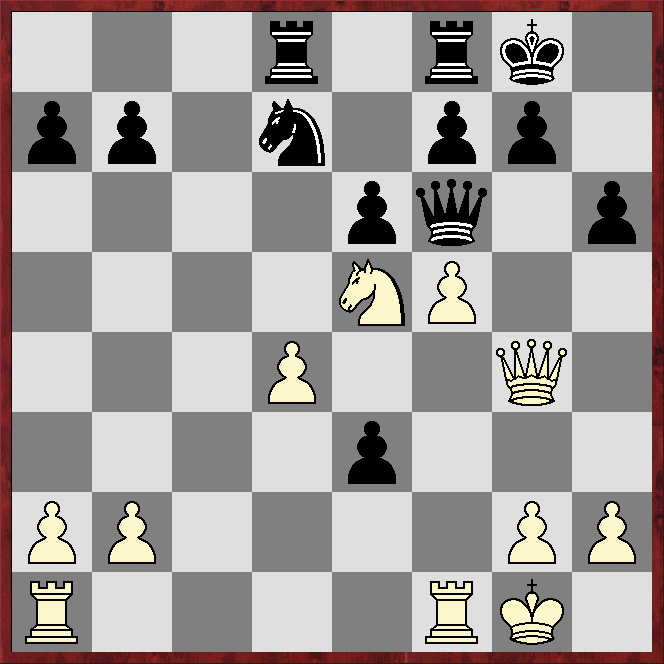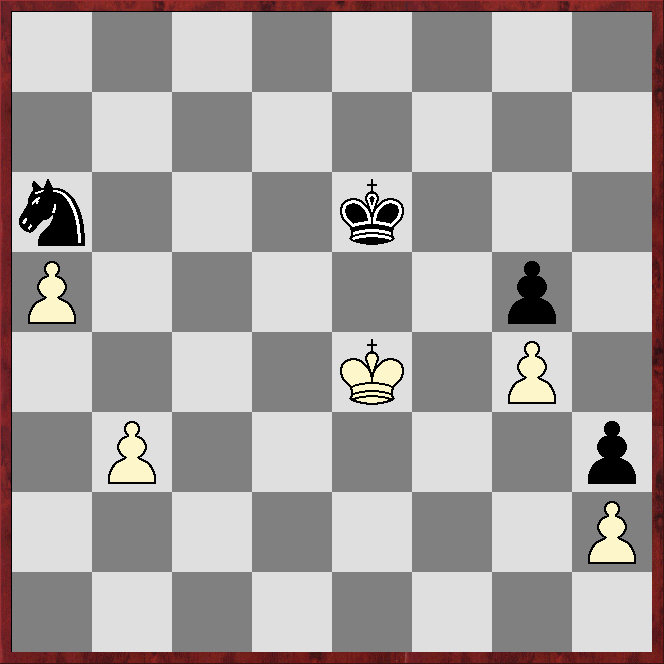Veresov
1.d4 d5 2.Nc3 Nf6 3.Bg5 Bf5
When Black develops the queen's bishop this way in double-d pawn games, a frequently recommended antidote is to attack the centre with c4, Nc3 and Qb3, but White's 2.Nc3 in the Veresov rules that out.
4.e3 e6 5.Bd3 Bg6 6.Nf3 Be7 7.Ne5!? Bxd3 8.cxd3!? h6
The text may be a novelty. Kurt Richter - Enrique Reinhardt, Telephone Team Match Berlin-Hamburg 1937, went 8...0-0 9.0-0 Nfd7!? 10.Bf4!? Nxe5 11.dxe5!? with a slight edge for Black, according to Stockfish15 and Komodo13.02 (but 1-0, 36 moves).
9.Bh4 Nbd7 10.0-0 0-0 11.f4 c5 12.dxc5 Nxc5 13.f5?!
This is probably overstretch.
*****
*****
*****
*****
13...d4
An awkward move to meet since 14.exd4?? Qxd4+ forks the white king, king's knight and queen's bishop.
14.Ne4?
Best seems to be 14.Nb5, eg 14...exf5 15.Nxd4 Nd5 16.Bf2 g6, when the engines reckon Black may have a slight edge.
14...dxe3 15.Bxf6?!
Probably better is 15.Nxc5, although 15...Qd4!? looks a good reply, eg 16.Qe2 Qxe5 17.Bxf6 Bxf6 18.Nd7 Qxb2 19.Rae1 Rfe8 20.fxe6 Qxe2 21.Nxf6+ gxf6 22.exf7+ Kxf7 23.Rxe2 - a complicated line, but it leaves Black with a large advantage, according to the engines.
15...Bxf6 16.Nxf6+ Qxf6 17.d4 Rad8 18.Qg4 Nd7!?
Possibly even stronger is the simple 18...e2 19.Qxe2 Rxd4.
*****
*****
*****
*****
19.Nxf7?
Like many promising combinations, this works in all lines but one. Probably best is 19.Nxd7 Rxd7 20.fxe6 Qxe6 21.Qxe6 fxe6 22.Rae1 Rxf1+ 23.Kxf1 Rxd4 24.Rxe3, with Black emerging up a passed pawn, but in a rook-and-pawn ending.
19...h5
Immediately capturing the knight is met by capturing on e6, but this intermezzo wins for Black.
20.Qe4
There is nothing better. but now ...
20...Qxf7 21.fxe6
.... can be met by the pinning:
21...Qe7
After ...
22.Qxe3
... White, at least temporarily, has two pawns for a knight, but Black is winning, according to the engines.
22...Rxf1+!?
Black wants to immediately go after one of the passed white pawns, but this develops the white queen's rook for free.
23.Rxf1 Nf8?!
Not the best, according to the engines, who like the calmer 23...Nf6.
24.Rf7?!
Tempting, but inferior to 24.Rf5 and to 24.h3!?, according to the engines.
24...Qd6 25.Rxb7 Nxe6 26.Rxa7 Nxd4
*****
*****
*****
*****
27.Qe7?
This allows a mating sequence, although Black is also winning after the engines' 28.Re7.
27...Qxe7?
Black wins quickly with 27...Ne2+, eg 28.Kf2 Qf4+! 29.Ke1 (29.Kxe2? Rd2+ 30.Ke1 Qf2#) Qd2+ 30.Kf1 Ng3+! 31.hxg3 Qd1+ 32.Kf2 (32.Qe1 Rf8+ etc) Rd2+ 33.Ke3 Re2+ - quite a long variation, but most of the moves are forcing.
28.Rxe7 Kf8 29.Rb7 Nc6 30.a4 Rd4?!
Probably the wrong idea. The usual rule-of-thumb, that rooks belong behind passed pawns, seems to hold true, so 30...Rd1+ 31.Kf2 Ra1 gives White the upper hand, according to the engines.
31.b3 Rb4?!
After the coming exchange of rooks, Black's material advantage in pieces goes, using traditional values, from 8:5 to 3:0. That is a massive jump in terms of ratio, but a knight is hard pressed to deal with flank pawns, so Black should probably keep rooks on.
32.Rxb4 Nxb4 33.Kf2 g5 34.Ke3 Ke7 35.Kd4 Kd6 36.Ke4 Ke6 37.a5 h4 38.g3!?
Komodo13.02 prefers 38.h3, but Stockfish15 is happy enough with the text.
38...h3
*****
*****
*****
*****
39.g4?
This loses, as does 39.Kd4?, but both 39.Ke3 and 39.Kf3 draw, eg 39.Ke3 Kf5 40.Kd2!? (40.Kd4!? also draws, according to the engines, but 40.Kf3? loses to 40...g4+) Ke4 41.Kc3 Nc6 42.a6 Kf3 43.b4 Na7 44.Kc4 Kg2 45.b5 Nc8! (45...Kxh2 loses) 46.Kc5 Kxh2 47.b6 Nxb6 48.Kxb6 Kg1 49.a7 h2 50.a8=Q h1=Q 51.Qa1+, after which the black king cannot escape being checked.
*****
*****
*****
*****
39...Na6
White is in zugzwang after 39...Kf6!, ie 40.Kd4 Nc6+ and 41...Nxa5, or 40.Ke3 Ke5 etc.
White is in zugzwang after 39...Kf6!, ie 40.Kd4 Nc6+ and 41...Nxa5, or 40.Ke3 Ke5 etc.
*****
*****
*****
*****
40.Kf3?
This loses by a tempo, whereas 40.Kd4 and 40.Kd3 draw, eg 40.Kd4 Kd6 (40...Nb4? 41.Kc5 wins for White) 41.Ke4.
40...Ke5 41.Kg3
If 41.Ke3, then 41...Nb4 wins.
41...Ke4 42.Kxh3 Kf3 43.b4 Nxb4 44.a6 Nd5 0-1
*Spanish rating.






No comments:
Post a Comment